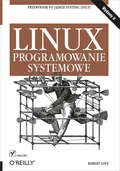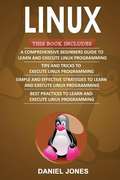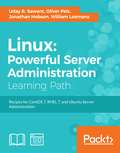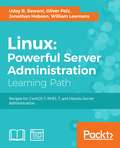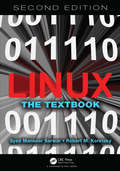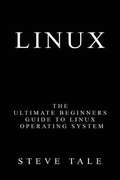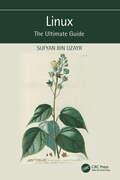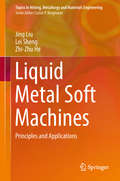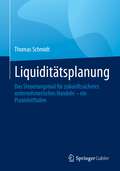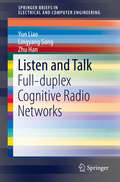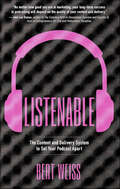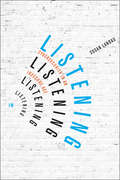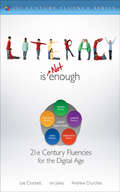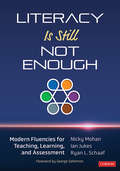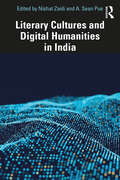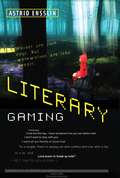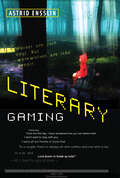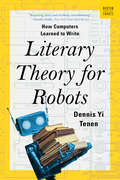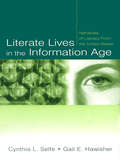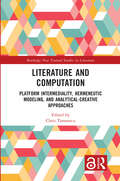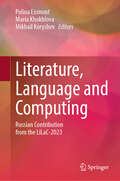- Table View
- List View
Linux. Programowanie systemowe. Wydanie II
by Robert LovePrzewodnik po j?drze sytemu Linux!J?dro systemu Linux to jeden z najwi?kszych projektów rozwijanych przez ogromn? spo?eczno??. Setki wolontariuszy dniami i nocami rozwijaj? najwa?niejszy element tego systemu operacyjnego. I robi? to naprawd? skutecznie! Ka?de kolejne wydanie Linuksa zawiera dziesi?tki nowinek oraz ulepsze? - jest coraz szybsze, bezpieczniejsze i po prostu lepsze. Jednak pocz?tkuj?cy programi?ci mog? mie? problemy z wykorzystaniem us?ug dostarczanych przez kernel. Masz obawy, ?e nie odnajdziesz si? w g?szczu mo?liwo?ci wspó?czesnego j?dra systemu Linux?Ta ksi??ka rozwieje je w mig. Jest to wyj?tkowa pozycja na rynku wydawniczym, zg??biaj?ca w?a?nie te tajemnice. W trakcie lektury nauczysz si? tworzy? niskopoziomowe oprogramowanie, które b?dzie si? komunikowa?o bezpo?rednio z j?drem systemu. Operacje wej?cia i wyj?cia, strumienie, zdarzenia, procesy to tylko cz??? elementów, które b?yskawicznie opanujesz. Ponadto nauczysz si? zarz?dza? katalogami i plikami oraz poznasz koncepcj? sygna?ów. Ksi??ka ta jest niezast?pionym ?ród?em informacji dla wszystkich programistów pracuj?cych z j?drem Linuksa. Docenisz t? lektur?!Poznaj:metody zarz?dzania procesamizastosowanie sygna?ówzaawansowane interfejsy wej?cia i wyj?ciaj?dro systemu od podszewki Poznaj j?dro systemu od podszewki!Robert Love - od wielu lat jest u?ytkownikiem i wspó?twórc? systemu Linux. Rozwija ?rodowisko graficzne GNOME oraz j?dro systemu. Pracuje jako projektant oprogramowania w firmie Google, by? te? cz?onkiem zespo?u projektuj?cego system operacyjny Android. Jest autorem licznych ksi??ek po?wi?conych programowaniu w systemie Linux.
Linux: A Comprehensive Beginners Guide to Learn and Execute Linux Programming
by Daniel JonesIf you want to learn Linux programming, there’s not a better book on the market for you. This Powerful pack of 4 books is going to assume you know absolutely nothing about Linux, then teach you everything from A-Z, some of the most significant topics that will be covered in this book are as follows: The most common and useful Linux command line tools How to write Bash scripts and automate your command line workflow How to program in C++ and Python How to understand and think about high-level programming concepts in order to become a better programmer in the end The differences between functional and object-oriented programming and how they apply to you You may be absolutely stumped and not know where to look. However, this book will teach you everything you need to know - and fast! Without mincing words, the book teaches you two programming languages, how to write scripts, and how to navigate the Linux command line very well. So what are you waiting for? Pick up a copy of this 4 Books bundle now and get to programming on Linux like a master!
Linux: Powerful Server Administration
by Jonathan Hobson William Leemans Oliver Pelz Uday R. SawantGet hands-on recipes to make the most of Ubuntu Server, CentOS 7 Linux Server and RHEL 7 Server About This Book • Get Linux servers up and running in seconds, • In-depth guide to explore new features and solutions in server administration • Maintain performance and security of your server solution by deploying expert configuration advice Who This Book Is For This Learning Path is intended for system administrators with a basic understanding of Linux operating systems and written with the novice-to-intermediate Linux user in mind. To get the most of this Learning Path, you should have a working knowledge of basic system administration and management tools. What You Will Learn • Set up high performance, scalable, and fault-tolerant back ends with web and database servers • Facilitate team communication with a real-time chat service and collaboration tools • Monitor, manage and develop your server's file system to maintain a stable performance • Gain best practice methods on sharing files and resources through a network • Install and configure common standard services such as web, mail, FTP, database and domain name server technologies • Create kickstart scripts to automatically deploy RHEL 7 systems • Use Orchestration and configuration management tools to manage your environment In Detail Linux servers are frequently selected over other server operating systems for their stability, security and flexibility advantages.This Learning Path will teach you how to get up and running with three of the most popular Linux server distros: Ubuntu Server, CentOS 7 Server, and RHEL 7 Server. We will begin with the Ubuntu Server and show you how to make the most of Ubuntu's advanced functionalities. Moving on, we will provide you with all the knowledge that will give you access to the inner workings of the latest CentOS version 7. Finally, touching RHEL 7, we will provide you with solutions to common RHEL 7 Server challenges.This Learning Path combines some of the best that Packt has to offer in one complete, curated package. It includes content from the following Packt products: 1)Ubuntu Server Cookbook 2)CentOS 7 Linux Server Cookbook, Second Edition 3)Red Hat Enterprise Linux Server Cookbook Style and approach This easy-to-follow practical guide contains hands on examples and solutions to real word administration problems and problems faced when building your RHEL 7 system from scratch using orchestration tools.
Linux: Powerful Server Administration
by Jonathan Hobson William Leemans Oliver Pelz Uday R. Sawant<P><P>Get hands-on recipes to make the most of Ubuntu Server, CentOS 7 Linux Server and RHEL 7 Server <P><P>About This Book <P><P>Get Linux servers up and running in seconds, <P><P>In-depth guide to explore new features and solutions in server administration <P><P>Maintain performance and security of your server solution by deploying expert configuration advice <P><P>Who This Book Is For <P><P>This Learning Path is intended for system administrators with a basic understanding of Linux operating systems and written with the novice-to-intermediate Linux user in mind. To get the most of this Learning Path, you should have a working knowledge of basic system administration and management tools. <P><P>What You Will Learn <P><P>Set up high performance, scalable, and fault-tolerant back ends with web and database servers <P><P>Facilitate team communication with a real-time chat service and collaboration tools <P><P>Monitor, manage and develop your server's file system to maintain a stable performance <P><P>Gain best practice methods on sharing files and resources through a network <P><P>Install and configure common standard services such as web, mail, FTP, database and domain name server technologies <P><P>Create kickstart scripts to automatically deploy RHEL 7 systems <P><P>Use Orchestration and configuration management tools to manage your environment <P><P>In Detail <P><P>Linux servers are frequently selected over other server operating systems for their stability, security and flexibility advantages.This Learning Path will teach you how to get up and running with three of the most popular Linux server distros: Ubuntu Server, CentOS 7 Server, and RHEL 7 Server. We will begin with the Ubuntu Server and show you how to make the most of Ubuntu's advanced functionalities. Moving on, we will provide you with all the knowledge that will give you access to the inner workings of the latest CentOS version 7. Finally, touching RHEL 7, we will provide you with solutions to common RHEL 7 Server challenges.
Linux: The Textbook, Second Edition
by Syed Mansoor Sarwar Robert M KoretskyLinux: The Textbook, Second Edition provides comprehensive coverage of the contemporary use of the Linux operating system for every level of student or practitioner, from beginners to advanced users. The text clearly illustrates system-specific commands and features using Debian-family Debian, Ubuntu, and Linux Mint, and RHEL-family CentOS, and stresses universal commands and features that are critical to all Linux distributions. The second edition of the book includes extensive updates and new chapters on system administration for desktop, stand-alone PCs, and server-class computers; API for system programming, including thread programming with pthreads; virtualization methodologies; and an extensive tutorial on systemd service management. Brand new online content on the CRC Press website includes an instructor’s workbook, test bank, and In-Chapter exercise solutions, as well as full downloadable chapters on Python Version 3.5 programming, ZFS, TC shell programming, advanced system programming, and more. An author-hosted GitHub website also features updates, further references, and errata. Features New or updated coverage of file system, sorting, regular expressions, directory and file searching, file compression and encryption, shell scripting, system programming, client-server–based network programming, thread programming with pthreads, and system administration Extensive in-text pedagogy, including chapter objectives, student projects, and basic and advanced student exercises for every chapter Expansive electronic downloads offer advanced content on Python, ZFS, TC shell scripting, advanced system programming, internetworking with Linux TCP/IP, and many more topics, all featured on the CRC Press website Downloadable test bank, work book, and solutions available for instructors on the CRC Press website Author-maintained GitHub repository provides other resources, such as live links to further references, updates, and errata
Linux: The Ultimate Beginners Guide To Linux Operating System
by Steve TaleLinux: The Ultimate Beginners Guide to Linux Operating System is a quick-reference guide that will walk you through installation, configuration, and usage of the Linux OS. If you are new to this operating system, this book will allow you to get complete instructions on how you can quickly use Linux on your computer, learn how to operate programs and browse the internet, and use shortcuts that will allow you to navigate through the operating system with ease. This book is designed in such a way that you do not have to read all the chapters subsequently – you can jump from one chapter or section to another, depending on what topic you need to look up.
Linux: The Ultimate Guide
by Sufyan bin UzayrLinux is one of the most widely used operating systems. It was created to provide a free or low-cost operating system for personal computer users. Linus Torvalds published Linux on September 17, 1991, and it was written in the C programming language. It has since earned a reputation for being a high-performing and efficient system. This is a fairly comprehensive operating system that includes a graphical user interface (GUI), TCP/IP, the Emacs editor, and the X Window System, among other features. Debian, Ubuntu, Fedora, Red Hat Linux, SUSE Linux, Gentoo, Kali Linux, and Linux Mint are some of the finest Linux distributions. Linux is a very popular operating system today because of features such as multiuser operating system management, multitasking paradigm, multiprogramming concepts, and virtual memory. Many corporations and individuals, as well as firms such as Canonical, use Linux for their servers because of security concerns and positive feedback from the user community. Linux is also used in mobile devices, smart TVs, etc. Key Features: • A step-by-step approach to problem solving and skill development • A quick run-through of the basic concepts, in the form of a “crash course” • An advanced, hands-on core concepts, with a focus on real-world problems • An industry-level coding paradigm, practice-oriented explanatory approach • A special emphasis on writing clean and optimized code, with additional chapters focused on coding methodology
Liquid Metal Soft Machines: Principles and Applications (Topics in Mining, Metallurgy and Materials Engineering)
by Jing Liu Lei Sheng Zhi-Zhu HeThis book discusses the core principles and practical applications of a brand new machine category: liquid-metal soft machines and motors. After a brief introduction on the conventional soft robot and its allied materials, it presents the new conceptual liquid-metal machine, which revolutionizes existing rigid robots, both large and small. It outlines the typical features of the soft liquid-metal materials and describes the various transformation capabilities, mergence of separate metal droplets, self-rotation and planar locomotion of liquid-metal objects under external or internal mechanism. Further, it introduces a series of unusual phenomena discovered while developing the shape changeable smart soft machine and interprets the related mechanisms regarding the effects of the shape, size, voltage, orientation and geometries of the external fields to control the liquid-metal transformers. Moreover, the book illustrates typical strategies to construct a group of different advanced functional liquid-metal soft machines, since such machines or robots are hard to fabricate using rigid-metal or conventional materials. With highly significant fundamental and practical findings, this book is intended for researchers interested in establishing a general method for making future smart soft machine and accompanying robots.
Liquiditätsplanung: Das Steuerungstool für zukunftssicheres unternehmerisches Handeln – ein Praxisleitfaden
by Thomas SchmidtDieses Buch fokussiert auf die Liquiditätsplanung, die die zukunftssichere und wirtschaftliche Fortführung eines Unternehmens und seine Zahlungsfähigkeit an erste Stelle stellt. Es widmet sich einer möglichst prognosegenauen Abbildung der zukünftigen Zahlungsströme des laufenden operativen Geschäftsmodells. Aufgrund der Zusammenführung von Planungsrechnungen, rechtlichen Vereinbarungen des Debitoren- und Kreditorenmanagements und Prognoseverfahren ist der Liquiditätsplan im Planungsuniversum einzigartig und sichert bei konsequenter und richtiger Anwendung die Unternehmensexistenz. Ziel dieses Praxisleitfadens ist ein konzeptionell stringentes und gleichzeitig praktisch orientiertes Planungsmodell, das mit einer beherrschbaren Toleranz Aufschluss über die Entwicklung der Liquidität des Unternehmens gibt – sowohl dem Management als auch den Finanzverantwortlichen –, um es erfolgreich in die Zukunft zu führen.
Lisp in Small Pieces
by Christian QueinnecThis is a comprehensive account of the semantics and the implementation of the whole Lisp family of languages, namely Lisp, Scheme and related dialects. It describes 11 interpreters and 2 compilers, including very recent techniques of interpretation and compilation. The book is in two parts. The first starts from a simple evaluation function and enriches it with multiple name spaces, continuations and side-effects with commented variants, while at the same time the language used to define these features is reduced to a simple lambda-calculus. Denotational semantics is then naturally introduced. The second part focuses more on implementation techniques and discusses precompilation for fast interpretation: threaded code or bytecode; compilation towards C. Some extensions are also described such as dynamic evaluation, reflection, macros and objects. This will become the new standard reference for people wanting to know more about the Lisp family of languages: how they work, how they are implemented, what their variants are and why such variants exist. The full code is supplied (and also available over the Net). A large bibliography is given as well as a considerable number of exercises. Thus it may also be used by students to accompany second courses on Lisp or Scheme.
List of The Informed Brain in a Digital World
by National Academies Keck Future InitiativeDigital media provide humans with more access to information than ever before-a computer, tablet, or smartphone can all be used to access data online and users frequently have more than one device. However, as humans continue to venture into the digital frontier, it remains to be known whether access to seemingly unlimited information is actually helping us learn and solve complex problems, or ultimately creating more difficulty and confusion for individuals and societies by offering content overload that is not always meaningful. Throughout history, technology has changed the way humans interact with the world. Improvements in tools, language, industrial machines, and now digital information technology have shaped our minds and societies. There has always been access to more information than humans can handle, but the difference now lies in the ubiquity of the Internet and digital technology, and the incredible speed with which anyone with a computer can access and participate in seemingly infinite information exchange. Humans now live in a world where mobile digital technology is everywhere, from the classroom and the doctor's office to public transportation and even the dinner table. This paradigm shift in technology comes with tremendous benefits and risks. Interdisciplinary Research (IDR) Teams at the 2012 National Academies Keck Futures Initiative Conference on The Informed Brain in the Digital World explored common rewards and dangers to Humans among various fields that are being greatly impacted by the Internet and the rapid evolution of digital technology. Keynote speaker Clifford Nass of Stanford University opened the dialogue by offering insight into what we already know about how the "information overload" of the digital world may be affecting our brains. Nass presented the idea of the "media budget," which states that when a new media emerges, it takes time away from other media in a daily time budget. When additional media appear and there is no time left in a person's daily media budget, people begin to "double book" media time. Personal computers, tablets, and smartphones make it easy to use several media simultaneously, and according to Nass, this double-booking of media can result in chronic multitasking, which effects how people store and manage memory. Although current fast-paced work and learning environments often encourage multitasking, research shows that such multitasking is inefficient, decreases productivity, and may hinder cognitive function. National Academies Keck Future Initiative: The Informed Brain in a Digital World summarizes the happenings of this conference.
Listen and Talk
by Zhu Han Lingyang Song Yun LiaoThis brief focuses on the use of full-duplex radio in cognitive radio networks, presenting a novel spectrum sharing protocol that allows the secondary users to simultaneously sense and access the vacant spectrum. This protocol, called "Listen-and-talk" (LAT), is evaluated by both mathematical analysis and computer simulations in comparison with other existing protocols, including the listen-before-talk protocol. In addition to LAT-based signal processing and resource allocation, the brief discusses techniques such as spectrum sensing and dynamic spectrum access. The brief proposes LAT as a suitable access scheme for cognitive radio networks, which can support the quality-of-service requirements of these high priority applications. Fundamental theories and key techniques of cognitive radio networks are also covered. Listen and Talk: Full-duplex Cognitive Radio Networks is designed for researchers, developers, and professionals involved in cognitive radio networks. Advanced-level students studying signal processing or simulations will also find the content helpful since it moves beyond traditional cognitive radio networks into future applications for the technology.
Listenable: The Content and Delivery System to Set Your Podcast Apart
by Bert WeissThere is great news and bad news when it comes to podcasting.The great news? Anybody can start a podcast. The bad news? Anybody can start a podcast. And it seems as if everyone is starting a podcast.A simple Google search reveals countless guides about how to start a podcast. From equipment to software, someone can go live with a new podcast in a matter of days with simple step-by-step instructions about recording and launching their show.But what’s lacking is simple and effective training on how to create a podcast that’s actually listenable—that makes listeners hit that subscribe button. In Listenable, syndicated morning-drive radio host, Bert Weiss, shares a simple content and delivery strategy anyone can use to produce a show that builds a large, loyal audience.
Listening In: Cybersecurity in an Insecure Age
by Susan LandauA cybersecurity expert and former Google privacy analyst’s urgent call to protect devices and networks against malicious hackers and misinformed policymakers New technologies have provided both incredible convenience and new threats. The same kinds of digital networks that allow you to hail a ride using your smartphone let power grid operators control a country’s electricity—and these personal, corporate, and government systems are all vulnerable. In Ukraine, unknown hackers shut off electricity to nearly 230,000 people for six hours. North Korean hackers destroyed networks at Sony Pictures in retaliation for a film that mocked Kim Jong-un. And Russian cyberattackers leaked Democratic National Committee emails in an attempt to sway a U.S. presidential election. And yet despite such documented risks, government agencies, whose investigations and surveillance are stymied by encryption, push for a weakening of protections. In this accessible and riveting read, Susan Landau makes a compelling case for the need to secure our data, explaining how we must maintain cybersecurity in an insecure age.
Literacy Is NOT Enough: 21st Century Fluencies for the Digital Age
by Ian Jukes Lee Crockett Andrew ChurchesHow to upgrade literacy instruction for digital learners Educating students to traditional literacy standards is no longer enough. If students are to thrive in their academic and 21st century careers, then independent and creative thinking hold the highest currency. The authors explain in detail how to add these new components of literacy: Solution Fluency Information Fluency Creativity Fluency Collaboration Fluency Students must master a completely different set of skills to succeed in a culture of technology-driven automation, abundance, and access to global labor markets. The authors present an effective framework for integrating comprehensive literacy or fluency into the traditional curriculum.
Literacy Is Still Not Enough: Modern Fluencies for Teaching, Learning, and Assessment
by Ian Jukes Nicky Mohan Ryan L. SchaafModern fluencies provide a platform for authentic teaching, learning, and assessment While reading, writing, and arithmetic remain important, they are no longer enough. For learners to thrive, they must move beyond traditional literacies to modern fluencies—the unconscious mental processes that are learned, adapted, and applied in the context of real-world problems and challenges. In this book, the authors unpack the fluencies (solution, information, creativity, communication, collaboration, and global citizenship) to reflect the relentless social, cultural, and economic shifts of modern times. Practical resources are presented alongside: Authentic Unit Plan Exemplars for each fluency Assessment rubric examples Discussion questions Learners today must master an entirely different set of essential skills and knowledge needed to succeed than previous generations. This book provides a practical framework for integrating new fluencies into traditional curriculum.
Literacy Is Still Not Enough: Modern Fluencies for Teaching, Learning, and Assessment
by Ian Jukes Nicky Mohan Ryan L. SchaafModern fluencies provide a platform for authentic teaching, learning, and assessment While reading, writing, and arithmetic remain important, they are no longer enough. For learners to thrive, they must move beyond traditional literacies to modern fluencies—the unconscious mental processes that are learned, adapted, and applied in the context of real-world problems and challenges. In this book, the authors unpack the fluencies (solution, information, creativity, communication, collaboration, and global citizenship) to reflect the relentless social, cultural, and economic shifts of modern times. Practical resources are presented alongside: Authentic Unit Plan Exemplars for each fluency Assessment rubric examples Discussion questions Learners today must master an entirely different set of essential skills and knowledge needed to succeed than previous generations. This book provides a practical framework for integrating new fluencies into traditional curriculum.
Literary Cultures and Digital Humanities in India
by Nishat Zaidi A. Sean PueThis book explores the use of digital humanities (DH) to understand, interpret, and annotate the poetics of Indian literary and cultural texts, which circulate in digital forms — in manuscripts — and as oral or musical performance. Drawing on the linguistic, cultural, historical, social, and geographic diversity of Indian texts and contexts, it foregrounds the use of digital technologies — including minimal computing, novel digital humanities research and teaching methodologies, critical archive generation and maintenance — for explicating poetics of Indian literatures and generating scholarly digital resources which will facilitate comparative readings. With contributions from DH scholars and practitioners from across India, the United States, the United Kingdom, and more, this book will be a key intervention for scholars and researchers of literature and literary theory, DH, media studies, and South Asian Studies.
Literary Gaming
by Astrid EnsslinIn this book, Astrid Ensslin examines literary videogames -- hybrid digital artifacts that have elements of both games and literature, combining the ludic and the literary. These works can be considered verbal art in the broadest sense (in that language plays a significant part in their aesthetic appeal); they draw on game mechanics; and they are digital-born, dependent on a digital medium (unlike, for example, conventional books read on e-readers). They employ narrative, dramatic, and poetic techniques in order to explore the affordances and limitations of ludic structures and processes, and they are designed to make players reflect on conventional game characteristics. Ensslin approaches these hybrid works as a new form of experimental literary art that requires novel ways of playing and reading. She proposes a systematic method for analyzing literary-ludic (L-L) texts that takes into account the analytic concerns of both literary stylistics and ludology.After establishing the theoretical underpinnings of her proposal, Ensslin introduces the L-L spectrum as an analytical framework for literary games. Based on the phenomenological distinction between deep and hyper attention, the L-L spectrum charts a work's relative emphases on reading and gameplay. Ensslin applies this analytical toolkit to close readings of selected works, moving from the predominantly literary to the primarily ludic, from online hypermedia fiction to Flash fiction to interactive fiction to poetry games to a highly designed literary "auteur" game. Finally, she considers her innovative analytical methodology in the context of contemporary ludology, media studies, and literary discourse analysis.
Literary Gaming (The\mit Press Ser.)
by Astrid EnsslinA new analytical framework for understanding literary videogames, the literary-ludic spectrum, illustrated by close readings of selected works.In this book, Astrid Ensslin examines literary videogames—hybrid digital artifacts that have elements of both games and literature, combining the ludic and the literary. These works can be considered verbal art in the broadest sense (in that language plays a significant part in their aesthetic appeal); they draw on game mechanics; and they are digital-born, dependent on a digital medium (unlike, for example, conventional books read on e-readers). They employ narrative, dramatic, and poetic techniques in order to explore the affordances and limitations of ludic structures and processes, and they are designed to make players reflect on conventional game characteristics. Ensslin approaches these hybrid works as a new form of experimental literary art that requires novel ways of playing and reading. She proposes a systematic method for analyzing literary-ludic (L-L) texts that takes into account the analytic concerns of both literary stylistics and ludology.After establishing the theoretical underpinnings of her proposal, Ensslin introduces the L-L spectrum as an analytical framework for literary games. Based on the phenomenological distinction between deep and hyper attention, the L-L spectrum charts a work's relative emphases on reading and gameplay. Ensslin applies this analytical toolkit to close readings of selected works, moving from the predominantly literary to the primarily ludic, from online hypermedia fiction to Flash fiction to interactive fiction to poetry games to a highly designed literary “auteur” game. Finally, she considers her innovative analytical methodology in the context of contemporary ludology, media studies, and literary discourse analysis.
Literary Theory for Robots: How Computers Learned to Write (A Norton Short #0)
by Dennis Yi Tenen“Surprising, funny and resolutely unintimidating.” —Jennifer Szalai, New York Times Book Review In the industrial age, automation came for the shoemaker and the seamstress. Today, it has come for the writer, physician, programmer, and attorney. Literary Theory for Robots reveals the hidden history of modern machine intelligence, taking readers on a spellbinding journey from medieval Arabic philosophy to visions of a universal language, past Hollywood fiction factories and missile defense systems trained on Russian folktales. In this provocative reflection on the shared pasts of literature and computer science, former Microsoft engineer and professor of comparative literature Dennis Yi Tenen provides crucial context for recent developments in AI, which holds important lessons for the future of humans living with smart technology. Intelligence expressed through technology should not be mistaken for a magical genie, capable of self-directed thought or action. Rather, in highly original and effervescent prose with a generous dose of wit, Yi Tenen asks us to read past the artifice—to better perceive the mechanics of collaborative work. Something as simple as a spell-checker or a grammar-correction tool, embedded in every word-processor, represents the culmination of a shared human effort, spanning centuries. Smart tools, like dictionaries and grammar books, have always accompanied the act of writing, thinking, and communicating. That these paper machines are now automated does not bring them to life. Nor can we cede agency over the creative process. With its masterful blend of history, technology, and philosophy, Yi Tenen’s work ultimately urges us to view AI as a matter of labor history, celebrating the long-standing cooperation between authors and engineers.
Literate Lives in the Information Age: Narratives of Literacy From the United States
by Cynthia L. Selfe Gail E. HawisherThis book chronicles the development of electronic literacies through the stories of individuals with varying backgrounds and skills. Authors Cynthia L. Selfe and Gail E. Hawisher employ these stories to begin tracing technological literacy as it has emerged over the last few decades within the United States. They selected 20 case studies from the corpus of more than 350 people who participated in interviews or completed a technological literacy questionnaire during six years of their study. The book is organized into seven chapters that follow the 20 participants in their efforts to acquire varying degrees of technological literacy. Each chapter situates the participants' life-history accounts in the cultural ecology of the time, tracing major political, economic, social, and educational events, factors, and trends that may have influenced--and been influenced by--literacy practices and values. These literacy histories are richly sown with information that can help those in composition and writing studies situate the processes of acquiring the literacies of technology in specific cultural, material, educational, and familial contexts. These case studies provide initial clues about combinations of factors that affect--and are affected by--technological literacy acquisition and development. The first-hand accounts presented here offer, in abundant detail, everyday literacy experiences that can help educators, parents, policymakers, and writing teachers respond to today's students in more informed ways.
Literature and Computation: Platform Intermediality, Hermeneutic Modeling, and Analytical-Creative Approaches (Routledge New Textual Studies in Literature)
by Chris TanasescuLiterature and Computation presents some of the most relevantly innovative recent approaches to literary practice, theory, and criticism as driven by computation and situated in digital environments. These approaches rely on automated analyses, but use them creatively, engage in text modeling but inform it with qualitative[-interpretive] critical possibilities, and contribute to present-day platform culture in revolutionizing intermedial ways. While such new directions involve more and more sophisticated machine learning and artificial intelligence, they also mark a spectacular return of the (trans)human(istic) and of traditional-modern literary or urgent political, gender, and minority-related concerns and modes now addressed in ever subtler and more nuanced ways within human-computer interaction frameworks. Expanding the boundaries of literary and data studies, digital humanities, and electronic literature, the featured contributions unveil an emerging landscape of trailblazing practice and theoretical crossovers ready and able to spawn and/or chart the witness literature of our age and cultures.
Literature in the Digital Age
by Adam HammondLiterature in a Digital Age: An Introduction guides readers through the most salient theoretical, interpretive, and creative possibilities opened up by the shift to digital literary forms such as e-books, digital archives, and electronic literature. While Digital Humanities (DH) has been hailed as the 'next big thing' in literary studies, many students and scholars remain perplexed as to what a DH approach to literature entails, and skeptical observers continue to see literature and the digital world as fundamentally incompatible. In its argument that digital and traditional scholarship should be placed in dialogue with each other, this book contextualizes the advent of the digital in literary theory, explores the new questions readers can ask of texts when they become digitized, and investigates the challenges that fresh forms of born-digital fiction pose to existing models of literary analysis.
Literature, Language and Computing: Russian Contribution from the LiLaC-2023
by Polina Eismont Maria Khokhlova Mikhail KoryshevThis book brings together the selected revised papers representing a multidisciplinary approach to language and literature. The collection presents studies performed using the methods of computational linguistics in accordance with the traditions of Russian linguistic and literary studies, primarily in line with the Leningrad (Petersburg) philological school. The book comprises the papers allocated into two sections discussing the study of corpora in language, translation, and literary studies and the use of computing in language teaching and translation and in emotional text processing. A unique feature of the presented collection is that the papers, compiled in one volume, allow readers to get an understanding of a wide range of research conducted in Saint Petersburg State University and other Russian leading scientific institutions. Both the classical tradition of Saint Petersburg philology and the results obtained with the help of new computer technologies as a sample of the symbiosis of technologies and traditions, which bring research to a qualitatively new level to arouse interest.
